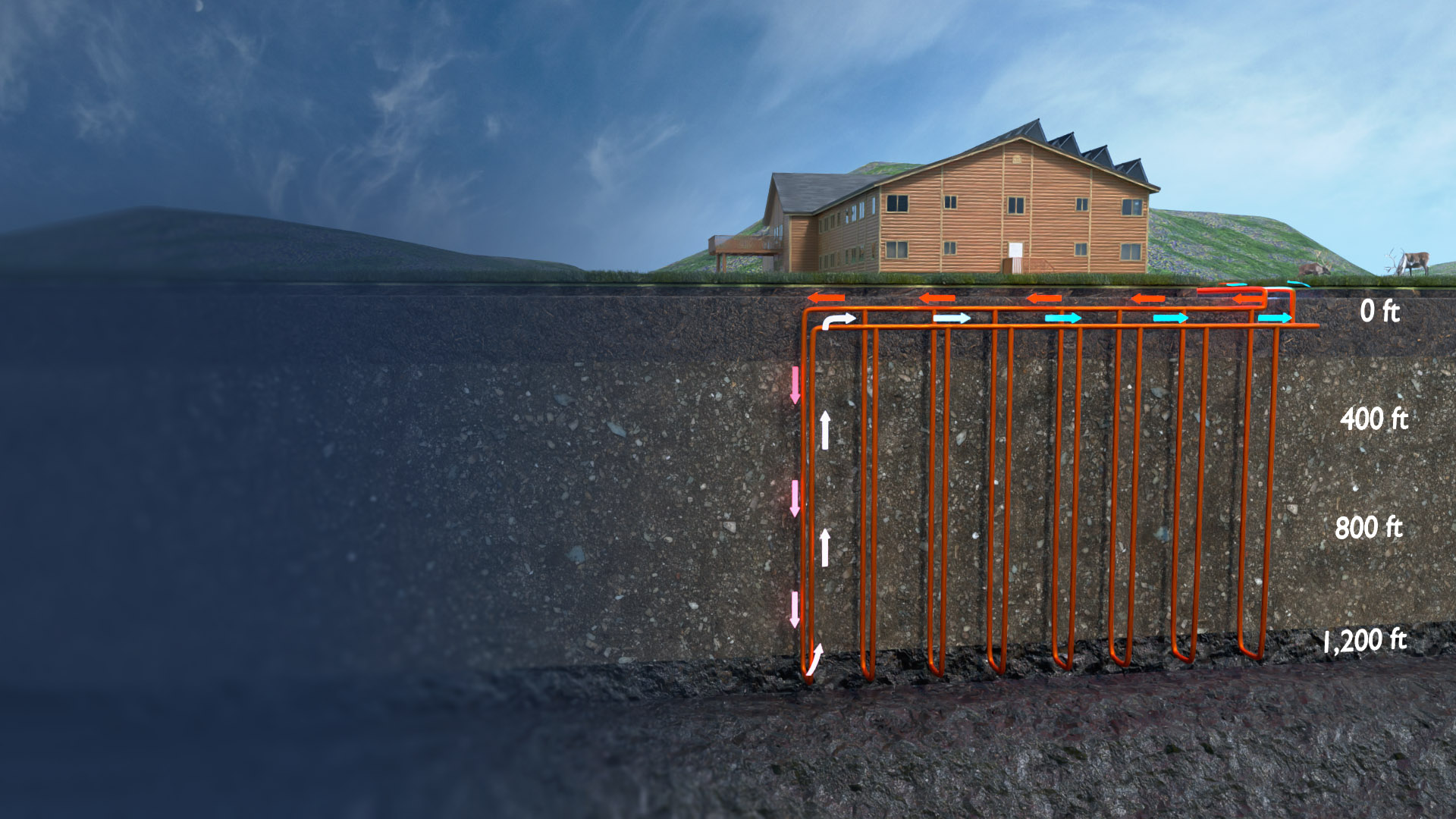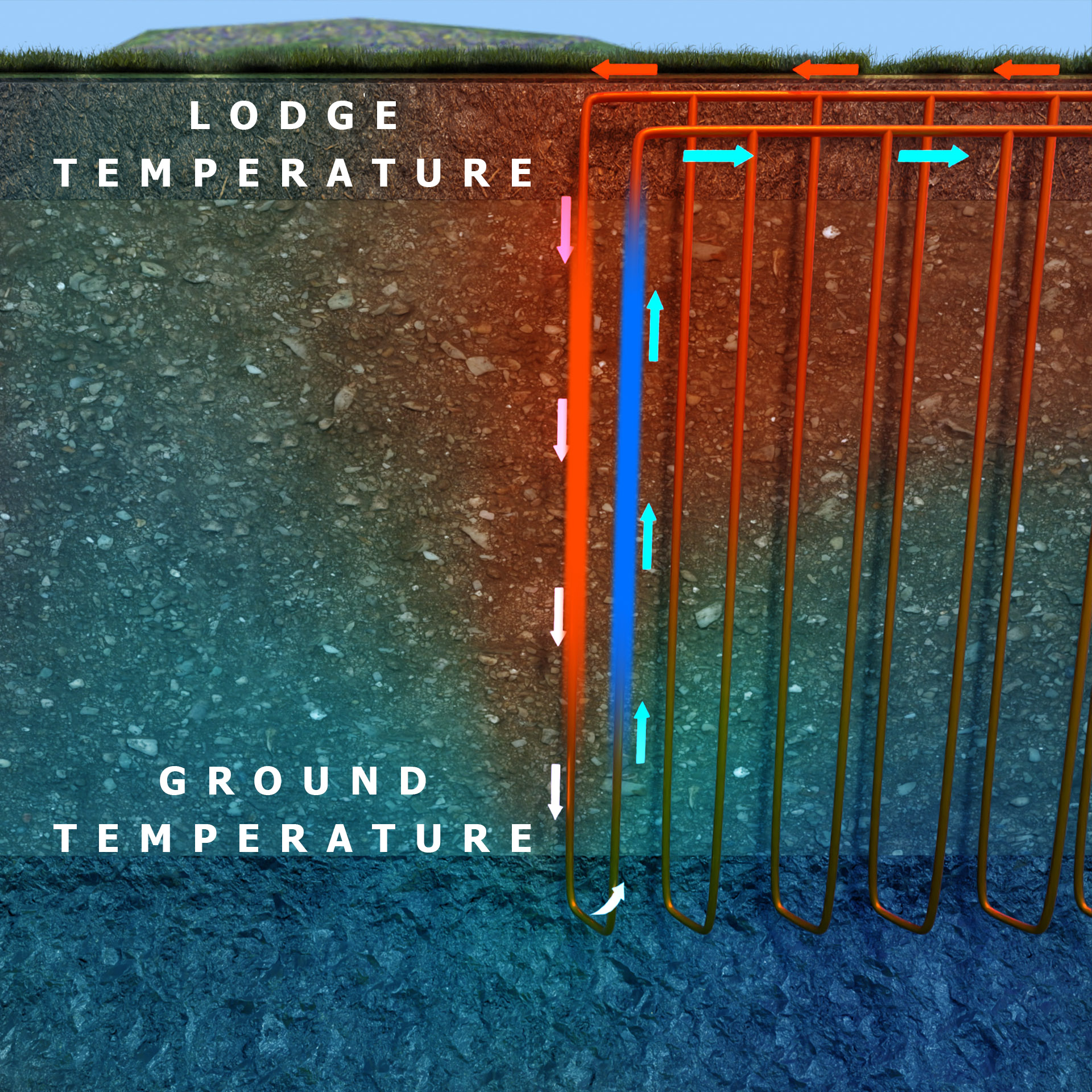

What is it?
Anvil Creek Lodge plans to use a vertical ground source heat pump system that consists of boreholes 1200 feet (365m) deep, each fitted with closed-loop U-shaped pipes through which a circulating heat-carrying fluid will absorb (or discharge) heat from (or to) the ground.
This technology has been used in more temperate climates where both heating and cooling is needed throughout the year. Demonstrating that vertical borehole heat pumps are a viable and cost effective alternative to burning heating oil is one of the goals of the Anvil Creek Lodge project.


How Will This be done?
Bore holes will be spaced about 16 feet (5m) apart, or double that depending on the conditions found while drilling. The first approximately 80 feet (24m) from the surface to bedrock will insulated from the extreme cold of this sub-arctic region's winters.
This closed-loop system does not affect the natural hydrology. The loops are sealed and grouted in place to improve thermal conductivity. Because open-loop systems rely on circulating ground water and sometimes hydraulic fracturing (fracking), we don't think these are appropriate for this region nor are they compatible with our philosophy.
Vertical systems rely on conduction of heat from surrounding geology. Since the major demand will be winter heating, with very little to no summer cooling load, the boreholes would cool over time and become less effective for heating. To remedy this, excess summertime solar electricity production will be used to heat the boreholes, thermally recharging the rock.
Vertical systems are better suited for this sub-arctic region, since they avoid the permafrost and the deep frostline that would be problematic with horizontal loop systems. No flames and no fumes, electric heat pumps are around four times more efficient than burning fuel for heat and can be powered with solar panels. The same system can be used for both heating and cooling.



How does a heat pump borehole work?
Rock is used as the heat source acting like a thermal battery, a closed-loop of fluid is placed in the rock, a heat pump circulates the fluid and extracts (or adds) heat from (to) the fluid, this warms (or cools) a building and/or domestic hot water.
Beneath our feet, the ground gets warmer and warmer the deeper you measure. At some point the ground is molten rock. We don't need to go this deep. Almost anywhere on Earth, if you go just a few hundred feet below the ground, the temerature of the rock is at least 50F.
A heat pump can pull out heat from one side and pump it into another side. This means that we don't need the rock aroud our borehole loop to be the 140F we are trying to heat our system to. A heat pump can take water that is 50 degrees Fairenheit and extract 10 Fairenheit degrees from say 1000 pounds of water in the borehole loop (returning 40F water into the borehole loop) and in turn heat 200 pounds of water in the surface system by 50 Fairenheit degrees. In this example 10,000 btu are pulled out of the ground instead of coming from burning heating oil. If the electrical power used to run the heat pump is provided by solar panels, then this is an emmissions free process during operation. The equipment still requires mining and energy to manufacture, so it's important to buy quality equipment and maintain it for a long service life.
In closed loop boreholes, a specialist drilling rig drills to depths of 200 feet to 2000 feet or more to form the borehole. A long U-shaped pipe is inserted into the borehole and connected via a trench to the ground source heat pump. The space around the U-pipe in the borehole is backfilled with a thermal grout to ensure thermal conductivity from the ground to the borehole pipe. The pipe near the surface, such as in the trench, is insulated. The borehole loop is connected to the heat pump.
The ground source heat pump circulates heat transfer fluid through the U-pipe. This cold fluid absorbs and moves the ground's low-grade energy towards the ground source heat pump. Some of the heat energy in the loop fluid is transfered by the heat pump to surface equipment, the cooled fluid returns to the borehole to begin the circuit all over again in a closed-loop, without absorbing or releasing ground water.
